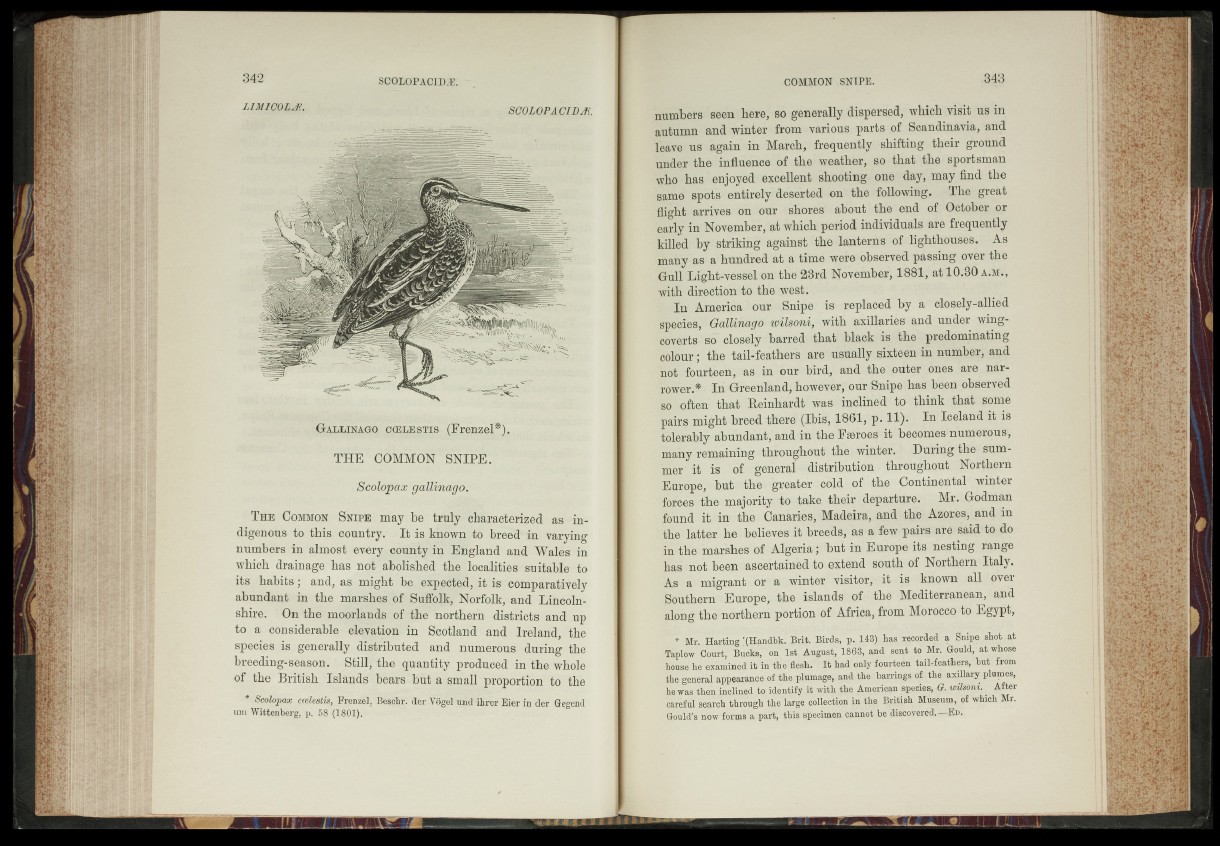
LIMIOOLÆ. SQOIOPACIBÆ.
Gallinago, g<EMSTis jfg^enzql*).
THE COMMOtff SNIPE.
VBcolopax galUnago-B
T h e C ommon S n ip e may be truly-'diraracterized as indigenous
to this country. It is, known to breeds in varying
numbers in almost every. couflty-ln England and Walds in
which drainage has n:<|f abolished the ^localities suitable to
its habits; and, as might be expected, it-is-comparatively
abundant in the marshes of Suffolk, Norfolk, and Lincolnshire.
On the moorlands of the' northern districts and up
|§ a considerable • elevation in Scotland and Ireland/ Hhe
species is generally distributed, and numerous during the
breeding-season. Still ƒ the quantity produced in-the whole
of . the British 'Islands' bears: but & small proportion'tcKtfis
* Scolopax c«death, Frenzel, Beschr. der V o ^ ln d 'd h re r Eier in del Gegend
uni Wittenberg, p.
numbers seen here, so generally dispersed, which .visit us in
autumn and winter from various parts of Scandinavia, and
leave us again in March, frequently shifting their ground
under the influence of the weather, so that the sportsman
who has enjoyed excellent shooting one day, may find’ the
same spots entirely’deserted on the following, The great
flight arrives on our shores about the end of Gctober or
early in November, at which period individuals are frequently
killed by striking against the lanterns' of lighthouses.1' :As
many as a hundred at a time were observed passing oyer the
Gull Light-vessel'on the 2Srd November, 1881, at 10.80 a.m.,
with direction to the *west; |
' In America 'o u r ..Snipe is replaced by a closely-allied
Species,1'ï€MUntiffi--wUs0m , with axillaries and under wing-
coverts so closely barred th a t black is the predominating
'éolour; the tail-feathers are'usually sixteen-in number, and
not fourteen, -as in our bird, and the outer ones are narrower.*
In Greenland, however, our-Snipe-has been'iöbserved
so' oftem: th a t Reinhardt was inclined to think that' some
pairs might'brë'ed there - (Ibis, 1861, p. 11)', ' In lc elaM it is
tolerably abundant,, and in 'the Faroes rity becomes-numerous,
many remaining throughout-the winter. During th e1 summ
e r''it is of general ' distribution , throughout-"Northern
f Europe, but the 'greater 'eèld-pfi the Continental winter
pforces the ma|oi%s«fco take their departure. Mr. Godman
hound it in ith e Ca-nams, Madeira, and-the-Azores, and in
th e latter he-belie-vesut breeds/ Ü a few' pair-s are said'to.-do
I jn?the marshes of-Algeria; but in: Europe'its nesting range
has not been ascertained to extend south of Northern Italy.
As a migrant .or* a winter v is ito r/-It. is «known all pvei I
Southern ^Europe, the islands^ o f-th é ''’Mediterranean/ and
along th e northern portion of Africa, from Morocco,to E^yft-
TTa.rt.îng ^ d a , ^ e c o ^ h a Sniye
T a p low ^ ^ ^B ,u .e is /‘'o n jïs tf August, 1 8 ^ ,.au d sent to Mr. Gould, at whMie
-lïéuW’he e|afniiedut%n the "flesh!'pit BaÆ'ondrfourtein tail-feathers, but' frdm
the. general appearance of tHe plumage, and the'barrings of the axillary plumes,
f e was tbsn mclij®! to American JP,eci^> M ■ After
^ rè fù l search through^help;^ . c o t t o n m the British Mdseutn, of which Mr.
J p i â ’sAbw fôrms’a part, this' specimen'cannot be''dîscoveréd.t-ED.